A Tribute to
Grandma Mellie
copyright © 1981, 1989, by Michael S. Cole, M.D.

This is a tribute to Mellie (HUNT) SMITH, a character who will be long remembered. Those who knew her have pleasant memories of her life. She had a special influence on me and her other grandchildren, most of whom called her "Grandma Mellie." Until the last few years of her life, she always seemed young. I suppose it was because she was truly young at heart and enjoyed the younger generation so. She said being around old folks depressed her.
She had a special place in her heart for all her grandchildren. She loved having them around. She claimed it made her feel younger. She once remarked, "If I had a hobby, I would say it is doing things for my grandchildren."
She began teaching us to make sugar cookies as soon as we were big enough to stand on a chair in her kitchen. She could make the best sugar cookies I have ever eaten. I remember her teaching me to write my name before I started to school. I can still vividly remember the sound of her whistling as she walked up the road, always wearing a sunbonnet.
We liked to hear her tell stories of the way people lived years ago. She loved to tell about her family and their lives in the community of Rock Springs. She liked to reminisce about how things had changed in the community since she was born. She could tell stories about fashions, living conditions, and the weather of the past. She told how the 4th of July was celebrated, and how they had Christmas without so much frills, but with just as much fun.
Mellie was born west of Harrison, Arkansas, on 29 October 1894, in a log house near where John SAXON now lives. The family was happy, though life was hard in those days in the Ozarks. Mellie grew up helping on the farm along with 2 brothers and 2 sisters. They had parents who served as good examples for them and for others in the community as well.
 Growing up was fun. When Mellie was little she used broken dishes and various sized tin cans in her kitchen when she played house. Like every American girl, she enjoyed playing with dolls. She learned to make dolls and continued to do so in later life. When about 6 years old, she buried a china-head doll in her yard. When she passed her birthplace as an adult, she would often remark that she wished she could find where she buried it and dig it up. She claimed she played with dolls until she was 15 years old. When she was older, she made a hobby of collecting them. There was never a large collection in her house, because she was always giving them away to her grandchildren and great-grandchildren.
Growing up was fun. When Mellie was little she used broken dishes and various sized tin cans in her kitchen when she played house. Like every American girl, she enjoyed playing with dolls. She learned to make dolls and continued to do so in later life. When about 6 years old, she buried a china-head doll in her yard. When she passed her birthplace as an adult, she would often remark that she wished she could find where she buried it and dig it up. She claimed she played with dolls until she was 15 years old. When she was older, she made a hobby of collecting them. There was never a large collection in her house, because she was always giving them away to her grandchildren and great-grandchildren.
Living closer to nature, Mellie learned a great deal from her father and grandmother, who taught her the trees, flowers, birds, and herbs used for medicine. Coming from such a background was undoubtedly the primary factor for her preference for the outdoors. With the exception of washing dishes, she was easily bored with the sameness of housework. Mellie was taught the art of basket making by her mother, but never had a true interest in developing that talent.
Mellie's family lived near many of their relatives. The closest neighbor, and most important to her as a young girl, was her grandmother Emily HAWKINS. She made a big impression on Mellie, who once said, "I have tried to be the kind of grandmother she was." On another occasion Mellie wrote, "I hope my grandchildren will remember me with love, as I remember my grandma, and one day pass on the stories I have told them to their own grandchildren."
Mellie recalled that at home her parents would occasionally punish her by making her hug one of the trees in the front yard for a given length of time. This was very embarrassing if someone happened to pass by.
She seemed to get into a lot of mischief when she was growing up. Once she caught a little lamb with the help of a friend. They took it upstairs in an empty house nearby to play with it. When the lamb got loose, it jumped out the window. They were afraid they had killed the little thing, but lucky for them, it got up and ran away.
Many years ago there was supposed to have been a petrified trough inside Ben Tye Cave, on the western edge of the Rock Springs Community. While trying to get a piece of the trough, Mellie and a playmate heard a growling in the darkness high on the ledge overhead. Without looking back they immediately hurried out of there, never to return even though they had gotten no petrified wood.
When Mellie was 13 years old, she and her cousin Nellie HAWKINS tied a white rag onto the tail of Whitey the cow. Whitey did not notice it at first, but when she looked around and saw it she took off. It scared the girls badly, until they caught up with her and removed the rag.
 Mellie was an ambitious schoolgirl. She walked one and a half miles to the Rock Springs School where about 40 pupils were taught. She completed 8 grades in that one-room schoolhouse. At age 15 she recited the poem "Independence Bell" in the bandstand at Harrison on July 4th.
Mellie was an ambitious schoolgirl. She walked one and a half miles to the Rock Springs School where about 40 pupils were taught. She completed 8 grades in that one-room schoolhouse. At age 15 she recited the poem "Independence Bell" in the bandstand at Harrison on July 4th.
To attend high school, Mellie went to live with her Grandpa HUNT. After a short time she became so homesick she quit and returned to Rock Springs. She regretted this decision for the rest of her life. She realized, "An education is something no one can take away from you. It is a joy as long as you live."
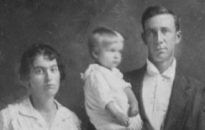 Her first date with a boy was at fifteen. At age 18, she was married on 17 April 1913, wearing a wedding dress made by her mother. Her husband was Edd WILSON, son of an Englishman who had come to America at age twelve. Mellie and Edd had their first child ten months after they married. Barely pregnant with her fourth child, Mellie became a widow at age 24.
Her first date with a boy was at fifteen. At age 18, she was married on 17 April 1913, wearing a wedding dress made by her mother. Her husband was Edd WILSON, son of an Englishman who had come to America at age twelve. Mellie and Edd had their first child ten months after they married. Barely pregnant with her fourth child, Mellie became a widow at age 24.
With four small boys to raise she suddenly was made aware that the carefree days of her childhood were now gone forever. She exemplified her character when she chose to face up to her responsibilities. She had to be provider, as well as mother, to her children. She worked at any paying job she could find, from plowing in the fields to doing housework for families in town, four miles away. Without many toys, the WILSON boys were creative in making entertainment. By today's standards they lived in poverty. Since Mellie never talked about the Depression era, it is assumed that it had little effect on their lifestyle.
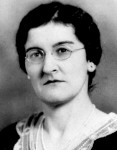 Having an aptitude for writing, Mellie enjoyed writing short articles for newspapers and magazines. Occasionally, she would be paid a few dollars for a story. She kept a scrapbook of newspaper clippings of most of her writings. She wrote about herself, her family, or her pioneer ancestors. She weekly reported the news from the Rock Springs Community for 59 years. These "local happenings" appeared in the Harrison Daily Times and Boone County Headlight. In later years she wrote many stories about her family's life in the Ozarks for a column called "Over The Ozarks" in the Springfield [Missouri] Daily News.
Having an aptitude for writing, Mellie enjoyed writing short articles for newspapers and magazines. Occasionally, she would be paid a few dollars for a story. She kept a scrapbook of newspaper clippings of most of her writings. She wrote about herself, her family, or her pioneer ancestors. She weekly reported the news from the Rock Springs Community for 59 years. These "local happenings" appeared in the Harrison Daily Times and Boone County Headlight. In later years she wrote many stories about her family's life in the Ozarks for a column called "Over The Ozarks" in the Springfield [Missouri] Daily News.
In the early 1930's, Mellie began corresponding with William COLE, a building contractor in California. He was also [believed to be] a widower who had a talent for writing and speaking. It seems they had little else in common, but on 5 December 1933 they were married in Harrison, Arkansas. She moved to California. After a few months she was so homesick that she compelled him to move to Arkansas.
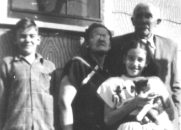 At first William did not want to have children, being afraid he would not live long enough to see them grown. Nevertheless, their first child was born 17 months after they married. Mellie then had a baby girl two years later. The COLE family had the necessities of life in those days, but never any luxuries. There was not even electricity to the house until 1947.
At first William did not want to have children, being afraid he would not live long enough to see them grown. Nevertheless, their first child was born 17 months after they married. Mellie then had a baby girl two years later. The COLE family had the necessities of life in those days, but never any luxuries. There was not even electricity to the house until 1947.
In the spring of 1959, Mellie's mother died. Then in the fall, William died. To lose two people so dear to her in such a short time was almost more than she could bear. She recovered from this stress through love and encouragement from her children and grandchildren. Since her children were grown, she was now faced with living alone for the first time in her life.
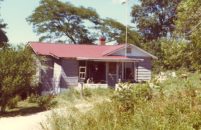 The little house she lived in is located near the center of Rock Springs on a hill. She had a sign on a tree in her yard which read "Hollyhock Hill." She had chosen that name because there were so many hollyhocks in her yard. She liked to collect odd-shaped rocks. She would paint them different colors and place them around the house and yard. She never had the luxury of indoor plumbing, but this place was her home for the last sixty years or so of her life.
The little house she lived in is located near the center of Rock Springs on a hill. She had a sign on a tree in her yard which read "Hollyhock Hill." She had chosen that name because there were so many hollyhocks in her yard. She liked to collect odd-shaped rocks. She would paint them different colors and place them around the house and yard. She never had the luxury of indoor plumbing, but this place was her home for the last sixty years or so of her life.

For several years after William's death she devoted herself to her grandchildren, most of whom lived in the community. During the summer she would have "vacation Bible school" at her house, usually under a shade tree. There were many children within walking distance, and most everyone attended regardless of their religion or age. She taught us stories primarily from the Gospels. She seemed to like the parables best and could tell them in a way that kept the attention of children of every age. She loved the singing as much as we did. Every child had to recite a "memory verse" of their own choosing each day during the week. For those too little to memorize something, she would insist they say, "Jesus wept." There was plenty of cookies and Kool-Aid for refreshments. Sometimes she would teach games that she played when she was a girl. I can recall none of the games, only that they were fun.
However, the most impressive thing about it all was that we were outside where we could see and hear things that God had made. Attending vacation Bible school inside a church house was never quite as interesting.
Mellie was baptized at age 14. It is difficult to say what religion she claimed. She could find something good in all of them. She once said she could never understand how people could spend more money at a movie on Saturday night than they would put into the collection plate on Sunday morning.
After meeting another man through correspondence, Mellie married Ralph PEERY at a ceremony in her yard on 5 July 1962. He was a widower, but had never had any children. He was expected to rapidly adjust to 21 grandchildren who were often around several at a time. Regrettably, he never quite learned how to deal with children, so he was avoided by them as much as possible.
Mellie never failed to keep children entertained. She always challenged our thinking or creativity. She had a box full of various kinds of buttons which we could string on a thread. She showed us how to sew doll clothes and cut out paper dolls. She helped us catch lightning bugs or June bugs in a jar. We enjoyed gathering eggs from her chickens. She would teach us appreciation for nature when we would walk together in a field or the woods. Though easily frightened, she was good-natured and always tolerated childhood pranks such as climbing trees or giving her a snake in a jar.
She could keep us interested with her story telling ability. Though she talked mostly of earlier years, she did not live in the past, but rather treasured her memories of it. She taught about our heritage, developing in many of us a deep appreciation for our ancestors, though they were simple, poor, pioneer farmers. She could tell the best stories about hoboes, superstitions, and ghosts. I am still not sure how much she believed them. One memorable story ended with the ghost being a rat dragging ears of corn down stairs.
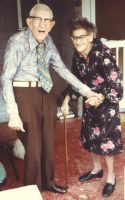 In January 1967, while Mellie was ill in the hospital, Ralph died. She did not want to live alone as she got older, but also did not want to be a burden to her children. It was no surprise that within a few months she found a widower, Luther SMITH, in Lead Hill, Arkansas, that she liked. She always had one or two grandchildren as "chaperones" when he would visit and stay overnight. They were married 5 September 1967 and shared many happy years together.
In January 1967, while Mellie was ill in the hospital, Ralph died. She did not want to live alone as she got older, but also did not want to be a burden to her children. It was no surprise that within a few months she found a widower, Luther SMITH, in Lead Hill, Arkansas, that she liked. She always had one or two grandchildren as "chaperones" when he would visit and stay overnight. They were married 5 September 1967 and shared many happy years together.
She wanted attention in her last years, but most of her grandchildren had moved out of the community by the late 1960's. Since she liked being around people, she would dream up reasons to go to town as often as possible. She never learned to drive. She always insisted on paying for the gas when she was given a ride. When told "That's too much," she would always respond, "A taxi would have cost me more."
She never wanted to grow up and certainly did not want to grow old. She had long black hair that did not start to gray until she was about 80 years old. Arthritis became a terrible plague to her and drained her of the energy that had kept her spirit young. She was convinced that the researchers looking for a cure for arthritis would never find one, because they would then be unemployed. Her arthritic pain, combined with decreasing visual acuity, considerably hampered reading and writing which she had enjoyed so much of her life. Her hearing decreased to the point that it was a serious handicap. Whether at the grocery store, bank, or restaurant, she always caused a scene in her last few years because it was so hard for her to understand what people said to her. As Luther was becoming hard of hearing, they created quite a commotion in public. This was usually an amusing site if you could keep from being embarrassed.
I last saw her alive in April 1980. Sitting on the side of her hospital bed, she was alert, but weaker than I had ever seen her. She had the attitude that she had struggled with life as long as she wanted. She knew she would never see her home on Hollyhock Hill again. Prior to this illness, she had expressed a fear of dying, but now seemed to be at peace with the thought that a home in Heaven awaited her.
After a stroke she was in a coma the last few weeks. A family member was at her bedside around the clock until she died on 7 June 1980. The chapel was packed at her funeral with those who had admired her. She was buried in Denning Cemetery, only about a mile from her home.
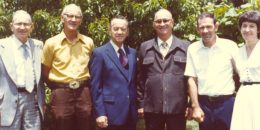
Johnny, Charles, Roy Lee, George WILSON, Billy COLE, June (COLE) CAMPBELL
You may link to a larger version of this photo {101KB}.
Use the "Back" button on your browser to return to this page.
The WILSON and COLE clan that remains is witness to her success. Her six children became hard workers, successfully serving others. They have had loving spouses and good homes of their own. Her list of descendants includes 22 grandchildren, 47 great-grandchildren, and 7 great-great-grandchildren. Sixty-three of these descendants were born during her lifetime.
She was witness to a lot of changes in the world during her lifetime. She appreciated the advances of this century in ways we never will. She wisely realized that not all things were good in the "good old days." It did seem to her that people were not as happy as they were when she was young.
 I will always remember Mellie SMITH as the short, humpbacked, country grandma that inspired me to set high goals and attain them. Though tender-hearted, she never held a grudge against anyone; she had nothing but love in her heart. I have never known anyone who was as generous as she was. If someone showed the slightest interest in anything around her house, she would offer it to them as a gift.
I will always remember Mellie SMITH as the short, humpbacked, country grandma that inspired me to set high goals and attain them. Though tender-hearted, she never held a grudge against anyone; she had nothing but love in her heart. I have never known anyone who was as generous as she was. If someone showed the slightest interest in anything around her house, she would offer it to them as a gift.
I feel sure she is in Heaven. And young again!
View a unique circular chart (in PDF format) of all Mellie's descendants in 1978.
For information about Grandpa COLE, please check out The TUMA-COLE Family Mystery
